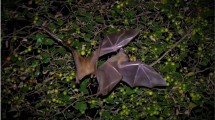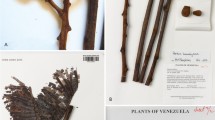Abstract
Fifteen species of neotropical and three species of paleotropical bats are known either to roost in or to make tents in over 80 species of vascular plants. We summarize the current knowledge of bat-tent architecture, report two new styles of tents (conical and apical) from the Paleotropics, compare the similarity in tents constructed, or used, by neotropical and paleotropical bats, and consider possible functions of tents. Seven styles of tents are known from the Neotropics, three (conical, palmate umbrella, and apical tents) are known from both the Neo- and the Paleotropics, and one (stem tent) is unique to the Paleotropics. In the Neotropics tent-roosting and/or tent-making appears to be a behavior unique to the diverse microchiropteran family Phyllostomidae (subfamily Phyllostomatinae: tribe Stenodermatini), and in the Paleotropics two members of the megachiropteran family Pteropodidae and one member of the microchiropteran family Vespertilionidae are known to construct or roost in tents. Despite the variety of plant taxa used by bats in tent construction, there appears to be a limited number of different leaf forms that can be altered by bats and used as tents. We suggest that the similarity in tent architecture observed among the neotropical and paleotropical bats is a consequence of convergence in leaf morphology among forest understory plants. The congruence in tent-making/roosting behavior observed in members of the Stenodermatini and the Pteropodidae (genusCynopterus) suggests a phylogenetic influence on these behaviors. The similarity in tent-making and/or tent-roosting behavior and life-history traits (small, <70 g, mostly foliage-roosting frugivores) among these divergent neotropical and paleotropical taxa supports a convergence hypothesis in which members of these groups have become ecological equivalents. Although actual tent-making has been observed in only one bat species to date, we suggest that the principal selective force leading to the evolution of tent-making is a polygynous mating system whereby males construct tents to gain access to females. Tents in turn provide resources that offer protection from predators and inclement weather.
Similar content being viewed by others
Literature Cited
Baker, R. J., Hood, C. S., and Honeycutt, R. (1989). Phylogenetic relationships and classification of the higher categories of the New World bat family Phyllostomidae,Syst. Zool. 38: 228–238.
Balasingh, J., Isaac, S., and Subbaraj, R. (1993). Tent-roosting by the frugivorous batCynopterus sphinx (Vahl 1797) in Southern India.Curr. Sci. 65: 418.
Balasingh, J. Koliraj, J., and Kunz, T. H. (1994). Tent construction by the short-nosed fruit bat,Cynopterus sphinx (Chiroptera: Pteropodiadae) in southern India.Ethology (in press).
Barbour, T. (1932). A peculiar roosting habit of bats.Q. Rev Biol. 7: 307–312.
Beard, J. S. (1946).The Natural Vegetation of Trinidad, Oxford University Press, London.
Bhat, H. R. (1994). Observations of the food regimen and feeding behaviour ofCynopterus sphinx Vahl (Chiroptera, Pteropodidae) in Pune, India.Mammalia (in press).
Bhat, H. R., and Kunz, T. H. (1994). Altered flower/fruit clusters of the kitul palm used as roosts by the short-nosed fruit bat,Cynopterus sphinx (Chiroptera: Pteropodidae).J. Zool. (Lond.) (in press).
Bloedel, P. (1955). Observations on life histories of Panama bats.J. Mammal. 36: 232–235.
Boinski, S., and Timm, R. M. (1985). Predation by squirrel monkeys and double-toothed kites on tent-making bats.Am. J. Primatol. 9: 121–127.
Boon, P. P., and Corlett, R. T. (1989). Dispersal of the lesser short-nosed fruit bat (Cynopterus brachyotis (Pteropodidae, Megachiroptera).Malay. Nat. J. 42: 251–256.
Brooke, A. P. (1987). Tent selection, roosting ecology and social organization of the tent-making bat,Ectophylla alba, in Costa Rica.J. Zool. (Lond.) 221: 11–19.
Brooke, A. P. (1990). Tent construction and social organization inVampyressa nymphaea (Chiroptera: Phyllostomidae) in Costa Rica.J. Trop. Ecol. 3: 171–175.
Brosset, A., and Charles-Dominique, P. (1990). The bats from French Guiana: A taxonomic, faunistic, and ecological approach,Mammalia 54: 509–560.
Buchanan, G. M. (1969).Bats of the Arima Valley, Trinidad, W. I., privately published, Asa Wright Nature Centre, Trinidad and Tobago.
Corbett, G. B., and Hill, J. E. (1992).The Mammals of the Indomalayan Region: A Systematic Review, British Museum Publications, Oxford University Press, Oxford.
Chapman, F. M. (1932). A home-making bat.Nat. Hist. 32: 555–556.
Charles-Dominique, P. (1993). Tent use by the batRhinophylla pumilio (Phyllostomidae: Carolliinae) in French Guiana.Biotropica 25: 111–116.
Choe, J. C. (1994). Ingenious design of tent roosts by Peter's tent-making bat,Uroderma bilobatum (Chiroptera: Phyllostomidae).J. Nat. Hist. (in press).
Choe, J. C., and Timm, R. M. (1985). Roosting site selection byArtibeus watsoni (Chiroptera: Phyllostomidae) onAnthurium ravenii (Araceae) in Costa Rica.J. Trop. Ecol. 1: 241–247.
Foster, M. S. (1992). Tent roosts of Macconnelli's bat (Vampyressa macconnelli).Biotropica 24: 447–454.
Foster, M. S., and Timm, R. M. (1976). Tent-making byArtibeus jamaicensis (Chiroptera: Phyllostomatidae) with comments on plants used by bats for tents.Biotropica 8: 265–269.
Gardner, A. L. (1977). Feeding habits. In:Biology of Bats of the New World Family Phyllostomatidae, Part II, R. J. Baker, J. K. Jones, Jr., and D. C. Carter, eds. pp. 293–350, Spec. Publ. Mus. Tex. Tech Univ., Lubbock.
Goodwin, R. E. (1979). The bats of Timor: Systematics and ecology.Bull Am. Mus. Nat. Hist. 163: 73–122.
Goodwin, G. G., and Greenhall, A. M. (1961). A review of the bats of Trinidad and Tobago: Descriptions, rabies infection, and ecology.Bull. Am. Mus. Nat. Hist. 122: 187–302.
Halle, F., Oldeman, R. A., and Tomlinson, P. D. (1978).Tropical Trees and Forests: An Architectural Analysis, Springer-Verlag, Berlin.
Hansell, M. H. (1984).Animal Architecture and Building Behaviour, Longman, London.
Holdridge, L. R. (1967).Life Zone Ecology, Tropical Science Center, San Jose, Costa Rica.
Ingles, L. G. (1953). Observations on Barro Colorado Island mammals.J. Mammal. 34: 266–268.
Kitchener, D. J., and Maharadatunkamsi (1991). Description of a new species ofCynopterus (Chiroptera: Pteropodidae) from Nusa Tenggara, Indonesia,Rec. West. Aust. Mus. 15: 307–363.
Kitchener, D. J., Boeadi, Charlton, L., and Maharadatunkamsi (1990).Wild Mammals of Lombok Island: Nusa Tenggara, Indonesia: Systematics and Natural History, Suppl. 33, Western Australian Museum, Perth.
Koepcke, J. (1984). “Blattzelte” also Schlafplatze der FledermausEctophylla-macconnelli (Thomas, 1901) (Phyllostomidae) in tronischen Regenwald von Peru.Saugetierkund. Mitt. 31: 123–126.
Koopman, K. F. (1993). Chiroptera. In:Mammalian Species of the World, 2nd ed., D. E. Wilson and D. M. Reeder, eds., pp. 137–241, Smithsonian Institution Press, Washington, DC.
Kunz, T. H. (1982). Roosting ecology of bats. In:Ecology of Bats T. H. Kunz, ed., pp. 1–55. Plenum Press, New York.
Kunz, T. H., and McCracken, G. F. (1994). Tents and harems: Apparent defense of foliage roosts by tentmaking bats.J. Trop. Ecol. (in press)
Lekagul, B., and McNeely, J. A. (1977).Mammals of Thailand, Association of Conservation and Wildlife, Kuruspha, Ladprao Press, Bangkok.
Lewis, S. E. (1992). Behavior of Peter's tent making bat,Uroderma bilobatum, at maternity roosts in Costa Rica.J. Mammal. 73: 541–546.
Lim, B. K. (1993). Cladistic reappraisal of neotropical stenodermatine bat phylogeny.Cladistics 9: 147–165.
Marshall, A. G. (1985). Old World phytophagous bats (Megachiroptera) and their food plants: A survey.Zool. J. Linn. Soc. 83: 351–369.
Mayo, S. J. (1986). Family 3—Araceae. In:Flora of Trinidad and Tobago, Part 3 pp. 291–366, Ministry of Agriculture, Lands and Food Production, Trinidad and Tobago.
Owen, R. D. (1987). Phylogenetic analysis of the bat subfamily Stenodermatinae (Mammalia: Chiroptera).Spec. Publ. Mus. Tex. Tech Univ. 26: 1–65.
Owen, R. D. (1988). Phenetic analysis of the bat subfamily Stenodermatinae (Chiroptera: Phyllostomidae).J. Mammal. 69: 795–810.
Phillips, W. W. A. (1924). A guide to the mammals of Ceylon, Part 1,Spolia Zeyl. 13: 1–63.
Phillips, W. W. A. (1980).Manual of the Mammals of Sri Lanka, 2nd rev. ed., Part 1, Wildlife and Nature Protection Society of Sri Lanka, Sri Lanka.
Richards, P. W. (1957).The Tropical Rain Forest, University Press, Cambridge.
Richardson, W. D. (1963). Observations on the vegetation and ecology of the Aripo Savannas, Trinidad.J. Ecol. 51: 295–313.
Rickart, E. A., Heideman, P. D., and Utzurrum, R. C. B. (1989). Tent-roosting byScotophilus kuhlii (Chiroptera: Vespertilionidae) in the Phillipines.J. Trop. Ecol. 5: 433–436.
Roth, I. (1984).Stratification of Tropical Forests as Seen in Leaf Structure, Dr. W. Junk, The Hague.
Simmonds, N. W. (1950). Notes on the biology of the Araceae of Trinidad.J. Ecol. 38: 277–291.
Simmonds, N. W. (1951). The Araceae of Trinidad and Tobago, BWI.Kew Bull. 1950: 391–406.
Timm, R. M. (1984). Tent construction byVampyressa in Costa Rica.J. Mammal. 65: 166–167.
Timm, R. M. (1987). Tent construction by the bats of the generaArtibeus andUroderma.Fieldiana Zool. (New Ser.) 9: 187–212.
Timm, R. M., and Mortimer, J. (1976). Selection of roost sites by Honduran white bats,Ectophylla alba (Chiroptera: Phyllostomatidae).Ecology 57: 385–389.
Timm, R. M., and Clauson, B. L. (1990). A roof over their feet.Nat. Hist. 3: 55–58.
Timm, R. M., and Lewis, S. E. (1991). Tent construction and use byUroderma bilobatum in coconut palms (Cocos nucifera) in Costa Rica.Bull. Am. Mus. Nat. Hist 206: 251–260.
Tomlinson, P. B. (1990).The Structural Biology of Palms, Oxford University Press, New York.
Author information
Authors and Affiliations
Rights and permissions
About this article
Cite this article
Kunz, T.H., Fujita, M.S., Brooke, A.P. et al. Convergence in tent architecture and tent-making behavior among neotropical and paleotropical bats. J Mammal Evol 2, 57–78 (1994). https://doi.org/10.1007/BF01464350
Issue Date:
DOI: https://doi.org/10.1007/BF01464350




